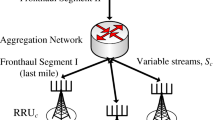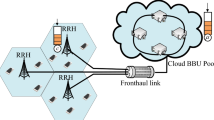Abstract
Coordinated multi-point (CoMP) is known to be one of the key technologies for long-term evolution (LTE)-advanced systems. CoMP technology can improve system capacity and the quality of wireless communication services for users in LTE networks. However, in practice, the actual performance of CoMP technology is limited by the switching capacity of the backhaul network among distributed base stations as well as its latencies. In this paper, we propose a new cloud radio access network architecture based on RF signal soft-switching to solve this problem. Furthermore, we introduce a narrow-band parallel processing technique on a common public radio interface in downlink and uplink to reduce the volume of data as well as the latencies in the transmission process among base band units and remote radio units. By combining theoretical analysis with computer simulations, we show that the technique is valid both for downlink and uplink, i.e., it does not degrade the performance of downlink and uplink propagation between BBU pool and user equipments. Moreover, the computational time of the narrow-band parallel processing technique is less than that of the standard technique.












Similar content being viewed by others
References
Wiart J (2012) Towards green mobile networks. Ann Telecommun 67(3–4):111–112
METIS (2013) Deliverable D1.1. Scenarios, requirements and KPIs for 5G mobile and wireless system. https://www.metis2020.com/documents/deliverables
Ong EH, Kneckt J, Alanen O, Chang Z, Huovinen T, Nihtila T (2011) IEEE 802.11ac: enhancements for very-high throughput WLANs. IEEE Personal Indoor and Mobile Radio Communications
Pham VH, Chouinard JY, Grenier D, Huynh HT, Wang X (2012) Spatio-temporal channel characterization: theoretical framework and applications in MIMO system design. Ann Telecommun 67(1–2):57–70
Perahia E, Gong MX (2011) Gigabit wireless LANs: an overview of IEEE 802.11ac and 802.11ad. ACM SIGMOBILE Mobile Computing and Communications Review 15(3):23–33
HUWEI. U-LTE: Unlicensed Spectrum Utilization of LTE., http://www.huawei.com/ilink/en/download/HW_327803
Trifina L (2014) Improved method for searching interleavers from a certain set using Garello’s method with applications for the LTE standard. Ann Telecommun 69(5–6):251–272
Khattab A, Bayoumi MA (2015) Standardization of cognitive radio networking: a comprehensive survey. Annals of Telecommunications
Bhaskar V, Dutta B (2014) Ergodic and outage capacity maximization of cognitive radio networks in cooperative relay environment using optimal power allocation. Ann Telecommun 69(11–12):621–632
Mitola III J (2009) Cognitive radio architecture evolution. Ann Telecommun 64(7–8):419–441
Flores AB, Guerra RE, Knightly EW, Ecclesine P (2013) IEEE 802.11af: a standard for TV white space spectrum sharing. IEEE Commun Mag 51(10):92–100
3GPP TS 36.300 (2011) Evolved Universal Terrestrial Radio Access (E-UTRA) and Evolved Universal Terrestrial Radio Access Network (E-UTRAN); Overall description; Stage 2
Nokia S N (2011) The advanced LTE toolbox for more efficient delivery of better user experience. Technical Whitepaper. NOKIA SIEMENS NETWORKS
CPRI Specification (2013) Common Public Radio Interface (CPRI). Interface Specification
Brueck S, Zhao L, Giese J, Amin MA (2010) Centralized scheduling for joint transmission coordinated multi-point in LTE-advanced. 2010 International ITG Workshop on Smart Antennas (WSA)
Li G, Zhang S, Yang X, Liao F (2012) Architecture of GPP based, scalable, large-scale C-RAN BBU pool. Globecom Workshops (GC Wkshps)
Chide N, Deshmukh S, Borole PB (2013) Implementation of OFDM system using IFFT and FFT. Int J Eng Res Appl 3(1):2009–2014
3GPP TS 36.211 (2013) Evolved Universal Terrestrial Radio Access (E-UTRA); Physical Channels and Modulation
3GPP TS 36.104 (2007) Evolved Universal Terrestrial Radio Access (E-UTRA); Base Station (BS) Radio Transmission and Reception
Bin G, Wei C, An T Resrearch on CPRI Compression Algorithm in LTE and LTE-Advanced System. Research and Development. http://www.chinaunicom.com/upload/1370411400010.pdf
Acknowledgments
The authors would like to thank anonymous referees for their helpful comments and suggestions, which significantly improve the results and presentation of this paper. This research is supported by National High Technology Research and Development Program (“863”Program) of China (2013AA013505).
Author information
Authors and Affiliations
Corresponding author
Appendix
Appendix
We now prove that the noise caused by I/Q equalization on CPRI is actually an additional noise.
For an arbitrary base signal {x i } which is generated and sampled in base station, it will be normalized, followed by I/Q equalization, before transmitted across CPRI. Let \(\{x_{i}^{\prime }\}\) and \(\{\bar {x}_{i}\}\) be the signals processed by normalization and equalization, respectively. We have
and
where Q is the number of bits of equalization.
After the base signal is received by RRU(s), it will be dequalized, followed by denormalization, obtaining original base signal. Let \(\{\tilde {x}_{i}\}\) be the restored signal. Thus,
Combine Eqs. 12, 13, and 14, we obtain
where a i is a number smaller than 1. Therefore,
We established the conclusion.
Rights and permissions
About this article
Cite this article
Lu, X., Xu, Y., Zhao, K. et al. A new C-RAN architecture based on RF signal soft-switching. Ann. Telecommun. 71, 1–14 (2016). https://doi.org/10.1007/s12243-015-0474-7
Received:
Accepted:
Published:
Issue Date:
DOI: https://doi.org/10.1007/s12243-015-0474-7




